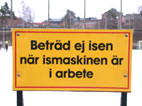GoodGuy
Posts: 1506
Joined: 5/17/2006
From: Cologne, Germany
Status: offline

|
quote:
ORIGINAL: Widell
....chunk of time can be anything from RTS to however long a turn is in a turn based game. What happens within the chunk is a simulation (not a game or anything else!) of event based on the current situation and the player input + a bunch of rules, calculations and a fair degree of randomness. Now, this computer stuff that goes on in the chunk can be more of less complicated and more or less transparent to the player, but it's "within the chunk" that I very much believe the quality of the game/sim/whatever is created. If each turn (yes, even FPS are based on turns, only very, very short ones  ).... )....
I wouldn't consider RTS or FPS to be based on turns. Action and reaction in real-time games shouldn't be confused with turns. In particular, if the player is free to move (his character[FPS] or his units[RTS]) anywhere at any time, then you can't refer to such an environment as a turn-based environment. Such an environment isn't a "real-time simultanous turn"-thingy either. Turn-based games carry restrictions and rules real-time simulations don't have. For instance, the fact that FPS single-player games incorporate tons of scripts, or that a certain amount of tiny mouse-movements ("chunks" ;P) are needed, in order to trigger your character's movements or actions, should not mislead you over their real-time core.
You mentioned COTA and HTTR, but although they might seem to be turn-based games under the hood, as scenarios unfold in 1-minute increments, they are not. Imo, this scale had been picked in order to make the scenario flow/progress more convenient for the player, as the player would not see much progress/movement if 1-second-increments would be used. Example: With maps of up to 40km x 50km, say a tank unit would just move a few meters per second only, infantry even less. So even if you would zoom in, movement would be barely visible (if at all).
Whatsoever, such games aren't turn-based, as even the number-crunching under their hoods, means the AI, will constantly assess and reassess the current situation, in an attempt to simulate real battle environments.... in real-time  , and not just when the player hits the "done" or "ready" button. , and not just when the player hits the "done" or "ready" button.
In turn, in RTS, even such "slow" movement speeds won't matter, as the scope of these games is way smaller: You usually command single platoons, or just even individual tanks, so that on this level the movement speed is still acceptable for the player.
In general, it is harder to develop an AI for real-time (or "pausable continuous time") games, as the AI has less time to act and react to the player's actions. This also involves more code, and it may even also involve more sophisticated routines if compared to turn-based games, as the computations have to be done continuously, and immediately after battle conditions have changed (eg. loss of main objective, unexpected losses, etc). And that's where many real-time fail, as in these cases their developers either either not have the resources or the knowledge to implement a decent AI.
A good example for AI-shortcomings in a real-time game would be "Theater of War 2". While this game features rather realistic physics (as it computes the travel path and penetration values of say individual bullets or tank rounds in real time, you often see APC rounds being deflected into the sky) and while it is anything than a RTS game, its AI heavily depends on scripts and its actions (keyword: klutz soldiers) create one or another good laugh (which can be frustrating too, though :P).
In recent RTS games, even in multiplayer skirmishes (where scripts - unlike in SP - are less useful) you'll still find routines that look like scripts, eg. the infamous "AT-gun advance" in "Company of Heros".
While that game's AI does carry some sophisticated and independent routines that will make the squads go for as many flags as possible, continuously, the main behaviour in skirmishes will be, besides producing other units, that it keeps spilling out AT-gun units, making it almost impossible for the player to attack with heavy armor (unless you collect them and try to overwhelm the enemy). So current RTS games rather seem to go for eye-candy and impressive (scripted) SP mission design, than for superb AI routines.
Anyway, RTS, FPS and real-time wargames aren't turn-based games, imho.
In turn , the AI in turn-based games usually has plenty of time to compute movement, possible threats etc., there are even some games which do the number-crunching while the player moves his units, the time needed for all these computations just comes down to the capabilities of the CPU. So, in my books, turn-based AIs can allow themselfs a luxury that real-time (sim)games can't afford. That's why I think that a decent AI in a continuous play game is worth a million more than a superb turn-based AI. , the AI in turn-based games usually has plenty of time to compute movement, possible threats etc., there are even some games which do the number-crunching while the player moves his units, the time needed for all these computations just comes down to the capabilities of the CPU. So, in my books, turn-based AIs can allow themselfs a luxury that real-time (sim)games can't afford. That's why I think that a decent AI in a continuous play game is worth a million more than a superb turn-based AI. 
Because of the differences (where I outlined some above), you can't put RTS, FPS, real-time games and turn-based games in one box and label it "turn-based", or "turn-based chunk container". It doesn't work like that, sorry. 
< Message edited by GoodGuy -- 12/9/2009 3:43:22 PM >
_____________________________
"Aw Nuts"
General Anthony McAuliffe
December 22nd, 1944
Bastogne
---
"I've always felt that the AA (Alied Assault engine) had the potential to be [....] big."
Tim Stone
8th of August, 2006
|
 Printable Version
Printable Version






 ), I launch the game and play the 1944 scenario and pick the US. I see neat animations, enhanced menues (compared to Hearts of Iron II), etc., in general: neat stuff.
), I launch the game and play the 1944 scenario and pick the US. I see neat animations, enhanced menues (compared to Hearts of Iron II), etc., in general: neat stuff.  I won't give them a bloody penny in the future until the game is working....that normally means bargain bin where you win on both counts.
I won't give them a bloody penny in the future until the game is working....that normally means bargain bin where you win on both counts. 









 ) generate a result that the player can accept as reasonable given the flavour of the game/sim/whatever, that's a winning concept! The Panther Games (COTA and HTTR for example) excel in this in my opinion. Then, there are other factors like comparing historical setup versus made up, or even fantasy setups, the length of the turn, truly turnbased to real-time pausible, to FPS, the scale of the operations, the implementation of supply, logistics and reinforcements, production or no production, diplomacy or no diplomacy. Each of these factors may or may not cater to the player's preferences.
) generate a result that the player can accept as reasonable given the flavour of the game/sim/whatever, that's a winning concept! The Panther Games (COTA and HTTR for example) excel in this in my opinion. Then, there are other factors like comparing historical setup versus made up, or even fantasy setups, the length of the turn, truly turnbased to real-time pausible, to FPS, the scale of the operations, the implementation of supply, logistics and reinforcements, production or no production, diplomacy or no diplomacy. Each of these factors may or may not cater to the player's preferences.  New Messages
New Messages No New Messages
No New Messages Hot Topic w/ New Messages
Hot Topic w/ New Messages Hot Topic w/o New Messages
Hot Topic w/o New Messages Locked w/ New Messages
Locked w/ New Messages Locked w/o New Messages
Locked w/o New Messages Post New Thread
Post New Thread